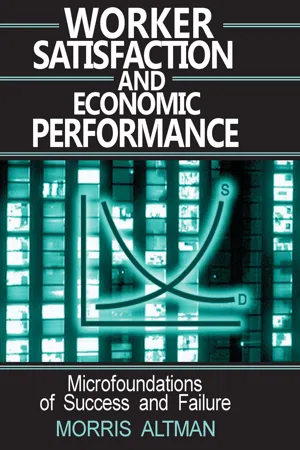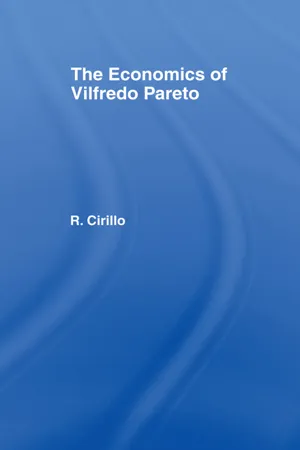Economic Efficiency
Economic efficiency refers to the optimal allocation of resources to maximize overall welfare. It occurs when goods and services are produced and distributed in a way that maximizes societal benefit while minimizing waste. This concept is a key focus in economic analysis and policy-making, aiming to achieve the most favorable outcomes for society as a whole.
6 Key excerpts on "Economic Efficiency"
- eBook - ePub
- Morris Altman(Author)
- 2020(Publication Date)
- Routledge(Publisher)
...Inefficient economic entities can survive in the marketplace. In this case, to the extent that economic inefficiency is a product of inefficient organization (either within the firm or in terms of the macroeconomic environment), distributional changes are consistent with the Pareto criteria for welfare maximization, and we move from the realm of a zero sum to a positive sum game. These results are also consistent with the work of Adam Smith and Arthur Cecil Pigou, where a dynamic causal relationship is posited between the distribution of income and the level of economic welfare, such that an equity-efficiency trade-off need not exist. In the behavioral model of economic welfare, which builds upon the insights of Smith and Pigou and where such a trade-off also need not exist, economic welfare is maximized in a Pareto Optimal sense only under an optimal or ideal organizational or institutional setting that would be characterized by a particular level or range of incomes, inclusive of nonpecuniary benefits, tied to the different groups of individuals engaged directly or indirectly in the process of production. Redistribution of income, in a broad sense, could then be justified with respect to its positive impact on total economic welfare, such that in effect the economy is moved from a Pareto-inefficient to a Pareto-efficient state over time as dynamic efficiencies are realized. Further redistributions of income, to the extent that they are efficiency neutral, would be a function of ethical or moral considerations from the Pareto perspective to the extent that they involve a reduction in the material welfare of at least one individual, assuming that the marginal utility of real income is equal across all individuals. Economic Welfare: The Conventional View The focus of the conventional wisdom is on economic welfare: that component of well-being that is related to the consumption of goods and services...
- eBook - ePub
- Peter Curwen(Author)
- 2006(Publication Date)
- Routledge(Publisher)
...CHAPTER TWENTY-ONE THE MAXIMIZATION OF WELFARE Introduction An important consideration to bear in mind throughout our discussion of welfare issues is that the social welfare function, which is central to our concern, is derived from the utility of members of the community, depending largely on what they consume. This, in turn, is determined by what is produced, and therefore depends on the productive resources available and the technical conditions of production. Consequently, there are various levels of efficiency to be considered. To start with, resources have to be used with maximum efficiency in production, otherwise more output is capable of being produced to the potential benefit of consumers. Secondly, the output produced needs to be allocated efficiently to consumers. Thirdly, the efficiency with which the product mix meets the demands of consumers has to be considered. Having considered all these aspects of efficiency we can then turn to the distributional issues. In what follows, to permit a diagrammatic exposition, we consider all these dimensions to the determination of maximum welfare in the context of an economy using two inputs, L and K, in the production of two goods X and Y, 1 which are then used by two consumers A and B. As usual, the results obtained from the analysis of this case are general in that they can be extended to situations with a larger number of inputs, products and consumers, but the diagrammatic approach has the advantage that it helps to provide a clearer understanding of what lies beneath the various conditions. Efficiency in production In our discussion of production we distinguished between technical and Economic Efficiency. Technical efficiency simply required the maximum output of a particular product to be obtained from the employment of a particular set of inputs...
- eBook - ePub
Microeconomics
A Global Text
- Judy Whitehead(Author)
- 2014(Publication Date)
- Routledge(Publisher)
...Moreover, it can be established that this general equilibrium can be achieved under a perfectly competitive economy. Much of the findings in the area of general equilibrium and welfare economics can be attributed to economist Arrow (1950, 1951, 1969). This is explained in greater detail as the topic is developed. Additional sources on the topic include Moore (2007) and Scarf (2008). The optimal allocation of resources With regard to resource allocation, the general equilibrium obtains when the following conditions hold: Every consumer chooses his/her preferred market basket subject to his/her given income (budget line). Every factor of production supplies its chosen quantity of inputs given the prevailing input and product prices. Every commodity producer maximizes profits subject to the constraints imposed by the available technology (production function), prices and supply of factor inputs. The quantity demanded is equal to the quantity supplied at the prevailing prices in all commodity and factor markets. It therefore represents an ideal state in the production and consumption of goods and services where there is the ‘best’ or most efficient use of given resources. 15.1.2 Concepts and tools of general equilibrium For simplicity, the model used to illustrate the achievement of a general equilibrium may be described as the ‘2 × 2 × 2’ model. This is a two-consumer (A, B), two-factor (K, L), two-commodity (x, y) model. The simplicity of this model is that it allows two-dimensional diagrams to be used for illustration. 15.1.2.1 The Pareto-Optimality Criterion At the centre of general equilibrium analysis is the concept of Pareto optimality or Pareto efficiency. This is a criterion that refers to Economic Efficiency which can be objectively measured...
- James E. Meade(Author)
- 2013(Publication Date)
- Routledge(Publisher)
...I Economic Efficiency and Distributional Justice The following pages are an exercise in the analysis of the dual function of the price mechanism. The price of a commodity or of a factor of production is a determinant both of the use which will be made of that commodity or factor of production and of the real income which the owner of the commodity or factor of production will receive as a result of its sale. These we will call the ‘efficiency’ and the ‘distributional’ aspects of the price. As is well known to all professional economists, relative prices properly used either in a competitive market or else by a planning authority can help to guide the economic system to an ‘efficient’ use of resources, that is to say, to a state of affairs in which resources are so used that it would be impossible to make one citizen better off without making any other worse off. For if a high price is charged for scarce resources and a low price for plentiful resources, their users will always try to satisfy their needs in ‘efficient’ ways which use relatively little of the scarce resources and relatively much of the plentiful resources; and this will be true whether the users be entrepreneurs buying materials and other factors of production as inputs into some productive process or whether they be housewives buying consumption goods and services. But such an ‘efficient’ system may, of course, lead to a very undesirable distribution of real wealth. If citizen A owns nothing except a factor (e.g. his own unskilled labour) whose price is low and needs for his family's welfare goods whose price is high, he will be very poor, as compared with citizen B who happens to own a factor (e.g...
- eBook - ePub
- Renato Cirillo(Author)
- 2012(Publication Date)
- Routledge(Publisher)
...Hence, an optimum position of welfare could be attained in a capitalistic society living within a competitive economy, as well as in a collectivist economy with its own type of social framework. The task of the economist, according to him, is to discover only the maxima of utility for a community rather than ‘the maximum utility of the community’. For in order to assess the latter we need to be in a position to compare the ophelimities of the various individuals, and ‘precisely because they cannot be compared, since they are heterogeneous quantities, no maximum ophelimity for the community can exist’. 4 There are still various interpretations of Pareto’s thought on this matter, but there is quite a universal consensus as to what constitutes a Pareto optimum: it indicates a position (organization or point) such that any change which makes some people better off results in making others worse off. In other words, if such a state is reached it is not possible to increase the utility of some consumers without diminishing that of others. So Pareto’s criterion leads to an ideal optimum, provided the income distribution is also ideal. If not, then it only helps us to understand how individuals can attain maximum welfare within the limits of their respective incomes. This could be demonstrated with the use of the familiar Edgeworth Box Diagram 5 reproduced on p. 44. In this diagram A and B could be initially at any point C where two of their indifference curves intersect. They could always improve their position if they move and reach a point of tangency (D or E) between any two of their indifference curves. At that point their marginal rates of substitution are equal. By finding similar points within the diagram and joining them we get what is termed the contract curve. Any point on the contract curve is a Pareto optimum and evidently any situation outside is inferior. But we cannot say more than that...
- eBook - ePub
Ethics and Economics
New perspectives
- Mark D. White, Irene van Staveren, Mark D. White, Irene van Staveren(Authors)
- 2013(Publication Date)
- Routledge(Publisher)
...In contrast, the second fundamental theorem states that (assuming convex preferences) any Pareto optimal allocation can be reached in a competitive market system through appropriate redistributions of initial endowments. Thus, equity questions are dealt with in this theorem and are in fact reduced to redistributions of initial assets. 2 Moreover, standard orthodoxy argues that economic analysis (sometimes referred to as positive economics) should primarily concentrate on analyzing efficiency issues, using particularly the Pareto criterion as the central tool of evaluation. In contrast, economists should generally desist from studying equity issues as these essentially entail value judgments (and thus belong to normative economics) where there is no criterion available to judge the relative merits of different values. 3 The main reason for this separation lies in the rather narrow criterion of Pareto optimality as the central welfare economic concept, which is also the key concept used in the two laws of welfare economics. Since Pareto optimality is really only a criterion of efficiency, welfare economic judgments of different Pareto optimal outcomes are not possible and are seen as normative issues outside the scope of neoclassical economics. The evolution of this view has been recounted and analyzed many times and need not detain us here (see Sen, 1999). The central motivating factor has been a reluctance to engage in inter-personal welfare comparisons, for which, according to Robbins (1935), there is no sound scientific foundation. Such welfare comparisons are seen as normative questions and are therefore outside the purview of positive economic analysis, or they are, as Robbins (1935, p. 53) famously remarked, ‘a case of thy blood or mine’. While this is the standard orthodoxy, several applied fields of economics have happily engaged in distributional judgments including implicit inter-personal comparisons (or related devices)...





